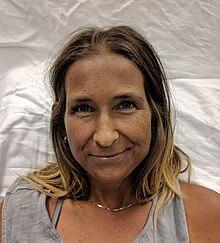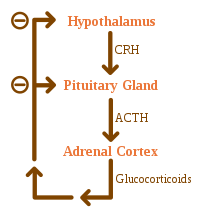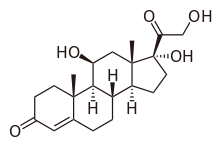Addison's disease
| Addison's disease | |
|---|---|
| Other names | Addison disease, primary adrenal insufficiency,[1] primary adrenocortical insufficiency, chronic adrenal insufficiency, chronic adrenocortical insufficiency, primary hypocorticalism, primary hypocortisolism, primary hypoadrenocorticism, primary hypocorticism, primary hypoadrenalism |
 | |
| Darkening of the skin seen on the legs of an otherwise fair-skinned patient. | |
| Specialty | Endocrinology |
| Symptoms | Abdominal pain, weakness, weight loss, darkening of the skin[1] |
| Complications | Adrenal crisis[1] |
| Usual onset | Middle-aged females[1] |
| Causes | Problems with the adrenal gland[1] |
| Diagnostic method | Blood tests, urine tests, medical imaging[1] |
| Treatment | Synthetic corticosteroid such as hydrocortisone and fludrocortisone[1][2] |
| Frequency | 0.9–1.4 per 10,000 people (developed world)[1][3] |
| Deaths | Doubles risk of death |
| Named after | Thomas Addison |
Addison's disease, also known as primary adrenal insufficiency,
Addison's disease arises from problems with the adrenal gland such that not enough of the steroid hormone cortisol and possibly aldosterone are produced.[1] It is an autoimmune disease which affects some genetically predisposed people in whom the body's own immune system has started to target the adrenal gland.[7] While it can follow tuberculosis, in many adult cases it is unclear what has triggered onset of the disease.[7] Causes can include certain medications, sepsis, and bleeding into both adrenal glands.[1][8] Addison's disease is generally diagnosed by blood tests, urine tests, and medical imaging.[1]
Treatment involves replacing the absent hormones.
Addison's disease affects about 9 to 14 per 100,000 people in the developed world.[1][3] It occurs most frequently in middle-aged females.[1] Secondary adrenal insufficiency is more prevalent.[3] The disease is named after Thomas Addison, a graduate of the University of Edinburgh Medical School, who first described the condition in 1855.[12][13]
Signs and symptoms

The symptoms of Addison's disease can develop over several months and resemble other medical conditions.
Blood tests in people with Addison's disease often reveal
Most people with Addison's disease develop or have a preexisting autoimmune disease.
Adrenal crisis
An "adrenal crisis" or "addisonian crisis" is a constellation of symptoms that indicates severe adrenal insufficiency. This may be the result of either previously undiagnosed Addison's disease, a disease process suddenly affecting adrenal function (such as
Characteristic symptoms are:[20]
- Sudden penetrating pain in the legs, lower back, or abdomen
- Severe vomiting and diarrhea, resulting in dehydration
- Low blood pressure
- Syncope (loss of consciousness and ability to stand)
- Hypoglycemia (reduced level of blood glucose)
- Confusion, psychosis, slurred speech
- Severe lethargy
- Hyponatremia (low sodium level in the blood)
- Hyperkalemia (elevated potassium level in the blood)
- Hypercalcemia(elevated calcium level in the blood)
- Convulsions
- Fever
Causes

Causes of adrenal insufficiency can be categorized by the mechanism through which they cause the adrenal glands to produce insufficient cortisol. This can be due to damage or destruction of the adrenal cortex. These deficiencies include glucocorticoid and mineralocorticoid hormones as well. These are adrenal dysgenesis (the gland has not formed adequately during development), impaired steroidogenesis (the gland is present but is biochemically unable to produce cortisol), or adrenal destruction (disease processes leading to glandular damage).[12]
Darkening (
Adrenal destruction
Autoimmune adrenalitis is the most common cause of Addison's disease in the industrialized world as it represents between 68% and 94% of cases.
Adrenal destruction is also a feature of
Adrenal dysgenesis
All causes in this category are genetic, and generally very rare. These include
Impaired steroidogenesis
To form cortisol, the adrenal gland requires
Diagnosis
Suggestive features
Routine laboratory investigations may show:[12]
- Low blood sugar(worse in children due to loss of glucocorticoid's glucogenic effects)
- free water in the absence of sufficient cortisol, and also the effect of corticotropin-releasing hormone to stimulate secretion of ADH.
- High blood potassium, due to loss of production of the hormone aldosterone.
- Eosinophilia and lymphocytosis (increased number of eosinophils or lymphocytes, two types of white blood cells)
- distal tubuleis linked with acid/hydrogen ion (H+) secretion. Absent or insufficient levels of aldosterone stimulation of the renal distal tubule lead to sodium wasting in the urine and H+ retention in the serum.
Testing


In suspected cases of Addison's disease, demonstration of low adrenal hormone levels even after appropriate stimulation (called the
The short test compares blood cortisol levels before and after 250 micrograms of tetracosactide (intramuscular or intravenous) is given. If one hour later, plasma cortisol exceeds 170 nmol/L and has risen by at least 330 nmol/L to at least 690 nmol/L, adrenal failure is excluded. If the short test is abnormal, the long test is used to differentiate between primary adrenal insufficiency and secondary adrenocortical insufficiency.[28]
The long test uses 1 mg tetracosactide (intramuscular). Blood is taken 1, 4, 8, and 24 hours later. Normal plasma cortisol level should reach 1,000 nmol/L by 4 hours. In primary Addison's disease, the cortisol level is reduced at all stages, whereas in secondary corticoadrenal insufficiency, a delayed but normal response is seen. Other tests may be performed to distinguish between various causes of hypoadrenalism, including
Treatment
Maintenance
Treatment for Addison's disease involves replacing the missing cortisol, sometimes in the form of hydrocortisone tablets, or prednisone tablets in a dosing regimen that mimics the physiological concentrations of cortisol. Alternatively, one-quarter as much prednisolone may be used for equal glucocorticoid effect as hydrocortisone. Treatment is usually lifelong. In addition, many people require fludrocortisone as a replacement for the missing aldosterone.[19]
People with Addison's are often advised to carry information on them (e.g., in the form of a MedicAlert bracelet or information card) for the attention of emergency medical services personnel who might need to attend to their needs.[30][31] A needle, syringe, and injectable form of cortisol are also recommended to be carried for emergencies.[31] People with Addison's disease are advised to increase their medication during periods of illness or when undergoing surgery or dental treatment.[31] Immediate medical attention is needed when severe infections, vomiting, or diarrhea occur, as these conditions can precipitate an Addisonian crisis. A person who is vomiting may require injections of hydrocortisone, instead.[32]
Those with low aldosterone levels may also benefit from a high-sodium diet. It may also be beneficial for the people with Addison's disease to increase their dietary intake of calcium and vitamin D. High dosages of corticosteroids are linked to osteoporosis so these may be necessary for bone health.[33] Sources of calcium include dairy products, leafy greens, and fortified flours among many others. Vitamin D can be obtained through the sun, oily fish, red meat, and egg yolks among many others. Though there are many sources to obtain vitamin D through diet, supplements are also an option.[citation needed]
Crisis
Standard therapy involves intravenous injections of glucocorticoids and large volumes of intravenous saline solution with dextrose (glucose). This treatment usually brings rapid improvement. If intravenous access is not immediately available, intramuscular injection of glucocorticoids can be used. When the person is capable of swallowing fluids and medications by mouth, the amount of glucocorticoids is decreased until a maintenance dose is reached. If aldosterone is deficient, maintenance therapy also includes oral doses of fludrocortisone acetate.[34]
Prognosis
Outcomes are typically good when treated. Most people can expect to live relatively normal lives. Someone with the disease should be observant of symptoms of an "Addison's crisis" while the body is strained, as in rigorous exercise or being sick, the latter often needing emergency treatment with intravenous injections to treat the crisis.[11]
Individuals with Addison's disease have more than a doubled
Death from individuals with Addison's disease often occurs due to cardiovascular disease, infectious disease, and malignant tumors, among other possibilities.[35]
Epidemiology
The frequency rate of Addison's disease in the human population is sometimes estimated at one in 100,000.[37] Some put the number closer to 40–144 cases per million population (1/25,000–1/7,000).[1][38][39] Addison's can affect persons of any age, sex, or ethnicity, but it typically presents in adults between 30 and 50 years of age.[39][40] Research has shown no significant predispositions based on ethnicity.[38] About 70% of Addison's disease diagnoses occur due to autoimmune reactions, which cause damage to the adrenal cortex.[5]
History
Addison's disease is named after
While the six under Addison in 1855 all had adrenal tuberculosis,[44] the term "Addison's disease" does not imply an underlying disease process.
The condition was initially considered a form of
Other animals
Hypoadrenocorticism is uncommon in dogs,[46] and rare in cats, with less than 40 known feline cases worldwide, since first documented in 1983.[47][48] Individual cases have been reported in a grey seal,[49] a red panda,[50] a flying fox,[51] and a sloth.[52]
In dogs, hypoadrenocorticism has been diagnosed in many breeds.[46] Vague symptoms, which wax and wane, can cause delay in recognition of the presence of the disease.[53] Female dogs appear more affected than male dogs, though this may not be the case in all breeds.[53][54] The disease is most often diagnosed in dogs that are young to middle-aged, but it can occur at any age from 4 months to 14 years.[53] Treatment of hypoadrenocorticism must replace the hormones (cortisol and aldosterone) which the dog cannot produce itself.[55] This is achieved either by daily treatment with fludrocortisone, or monthly injections with desoxycorticosterone pivalate (DOCP) and daily treatment with a glucocorticoid, such as prednisone.[55] Several follow-up blood tests are required so the dose can be adjusted until the dog is receiving the correct amount of treatment, because the medications used in the therapy of hypoadrenocorticism can cause excessive thirst and urination if not prescribed at the lowest effective dose.[55] In anticipation of stressful situations, such as staying in a boarding kennel, dogs require an increased dose of prednisone.[55] Lifelong treatment is required, but the prognosis for dogs with hypoadrenocorticism is very good.[53]
References
- ^ a b c d e f g h i j k l m n o p q r s t u v w x y "Adrenal Insufficiency and Addison's Disease". National Institute of Diabetes and Digestive and Kidney Diseases. May 2014. Archived from the original on 13 March 2016. Retrieved 13 March 2016.
- ^ S2CID 13732181. Archived from the originalon 2019-10-31. Retrieved 2019-10-31.
- ^ PMID 24424183.
- PMID 12689470.
- ^ a b c d "Addison's Disease". NORD (National Organization for Rare Disorders). Retrieved 2020-12-01.
- ^ PMID 37056413.
- ^ PMID 30144040.
- ISBN 9780702061288. Archivedfrom the original on 14 March 2016.
- PMID 23177474.
- ISBN 9780198570714. Archivedfrom the original on 14 March 2016.
- ^ a b "Addison's disease – Treatment". NHS Choices. Archived from the original on 9 October 2016. Retrieved 8 October 2016.
- ^ PMID 11443143.
- ISBN 9780123849304. Archivedfrom the original on 14 March 2016.
- ^ S2CID 259904961.
- ^ S2CID 232173232.
- ^ PMID 34512551.
- ^ "Autoimmune polyglandular syndrome type 1 | Genetic and Rare Diseases Information Center (GARD) – an NCATS Program". rarediseases.info.nih.gov. Archived from the original on 12 April 2017. Retrieved 26 June 2017.
- ^ "Autoimmune polyglandular syndrome type 2 | Genetic and Rare Diseases Information Center (GARD) – an NCATS Program". rarediseases.info.nih.gov. Archived from the original on 13 April 2017. Retrieved 26 June 2017.
- ^ a b "Adrenal Insufficiency and Addison's Disease". The Lecturio Medical Concept Library. Retrieved 27 June 2021.
- ^ "Addison's Disease". National Endocrine and Metabolic Diseases Information Service. Archived from the original on 28 October 2007. Retrieved 26 October 2007.
- PMID 25098712.
- PMID 31223468.
- S2CID 19666235.
- S2CID 205339997.
- ^ Kennedy R. "Addison's Disease". The Doctors' Medical Library. Archived from the original on 12 April 2013. Retrieved 10 April 2013.
- PMID 12899587.
- ^ Holt EH (2008). "ACTH (cosyntropin) stimulation test". MedLine Plus. U.S. National Library of Medicine.
- ^ a b "Addison's Disease". wasiclinic. 2021-07-14. Retrieved 2022-05-27.[permanent dead link]
- PMID 8636252.
- PMID 25498511.
- ^ from the original on 5 September 2015.
- ^ White K (28 July 2004). "What to do in an emergency – Addisonian crisis". Addison's Disease Self Help Group. Archived from the original on 4 March 2016. Retrieved 28 January 2013.
- ^ "Eating, Diet, and Nutrition for Adrenal Insufficiency & Addison's Disease | NIDDK". National Institute of Diabetes and Digestive and Kidney Diseases. Retrieved 2020-12-03.
- ^ "Adrenal Insufficiency and Addison's Disease". National Endocrine and Metabolic Diseases Information Service. Archived from the original on 26 April 2011. Retrieved 26 November 2010.
- ^ PMID 16968806.
- ^ Chantzichristos D, Persson A, Eliasson B, Miftaraj M, Franzén S, Bergthorsdottir R, et al. (1 April 2016). "Patients with Diabetes Mellitus Diagnosed with Addison´s Disease Have a Markedly Increased Additional Risk of Death". Cushing Syndrome and Primary Adrenal Disorders. Meeting Abstracts. Endocrine Society. Archived from the original on 9 June 2021. Retrieved 9 June 2021.
- ^ "Addison Disease". MedicineNet. Archived from the original on 24 June 2007. Retrieved 25 July 2007.
- ^ a b Odeke S. "Addison Disease". eMedicine. Archived from the original on 7 July 2007. Retrieved 25 July 2007.
- ^ a b "Addison's disease". nhs.uk. 2018-06-22. Retrieved 2020-10-14.
- ISBN 978-0-8493-6849-3.
- ^ Addison T (1855). On The Constitutional And Local Effects Of Disease Of The Supra-Renal Capsules. London: Samuel Highley. Archived from the original on 14 April 2005.
- PMID 25098712.
- ^ Physician and Surgeon. Keating & Bryant. 1885.
- PMID 18591375.
- PMID 15409948.
- ^ PMID 20357943.
- ^ Drobatz KJ, Costello MF (2010). Feline Emergency & Critical Care Medicinem. Ames, Iowa: Blackwell Publ. pp. 422–424.
- ISBN 9781119269038.
- ^ Stringfield CE, Garne M, Holshuh HJ (2000). Addison's disease in a gray seal (Halichoerus grypus). International Association for Aquatic Animal Medicine Proceedings.
- ^ Sohn P (10 February 2012). "Endangered red panda dies at Chattanooga Zoo". Times Free Press. Retrieved 25 August 2018.
- S2CID 38918707.
- S2CID 20775341.
- ^ ISBN 978-1-4557-4456-5.
- PMID 25813849.
- ^ PMID 30050862.
External links
- Addison's disease at Curlie
